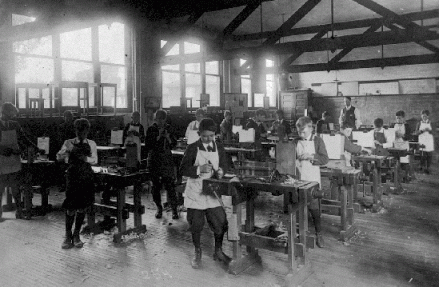Manual Labor Schools
Manual labor schools were the forerunner of the North Carolina Community College System. They were created to  provide an education that would help young people become working members of their communities. Practical in nature, these schools put less emphasis on academics than traditional schools in their attempt to develop a skilled work force essential to the state's economic development.
provide an education that would help young people become working members of their communities. Practical in nature, these schools put less emphasis on academics than traditional schools in their attempt to develop a skilled work force essential to the state's economic development.
Manual labor schools were begun in the 1830s in the United States, but they did not become popular in the South until after the Civil War. Prior to this time, manual labor was looked down upon by the upper class, and poor white boys generally worked on their families' farms. As society changed following the Civil War, manual labor schools evolved to offer trade skills for females as well as males. The schools could be public, private, or church-run and were variously operated for the poor and orphaned on the elementary, secondary, and more advanced levels.
The current North Carolina Community College System does not include the manual labor component of the earlier schools, and the system is much expanded to include a two-year college program. But the emphasis on providing a wide base of training for the citizens of North Carolina to fill jobs in the community continues to be a main emphasis of the current system.
References:
Charles William Dabney, Universal Education in the South, vol. 2 (1936).
Ben E. Fountain Jr., The Community College System in North Carolina: A Brief History (1990).
Image Credit:
Manual Training School, 1915. South Park School, Victoria. Courtesy of British Columbia Archives. Available from # (accessed September 19, 2012).
Additional Resources:
Manual Labor School, Davidson College: http://sites.davidson.edu/archives/encyclopedia/manual-labor
1 January 2006 | Fowlkes, Jim